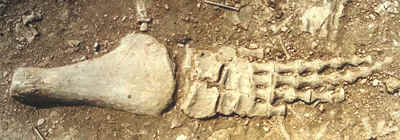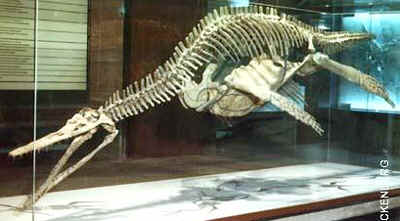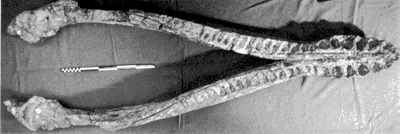
| Palaeos |  |
Sauropterygia |
| Vertebrates | Pliosauridae (2) |
| Page Back | Unit Home | Unit Dendrogram | Unit References | Taxon Index | Page Next |
| Unit Back | Vertebrates Home | Vertebrate Dendrograms | Vertebrate References | Glossary | Unit Next |
|
Abbreviated Dendrogram
DIAPSIDA |--ARCHOSAUROMORPHA `--LEPIDOSAUROMORPHA |--SAUROPTERYGIA | |--Placodontia | |--Pachypleurosauridae | `--+--Nothosauridae | `--Plesiosauria | |--Pliosauroidea | | |--Rhomaleosauridae | | `--Pliosauridae | | |--Kronosaurus | | `--+--Peloneustes | | `--+--Liopleurodon | | `--+--Pliosaurus | | `--Brachauchenius | `--Plesiosauroidea | |--Elasmosauridae | `--Cryptocleidoidea `--Lepidosauriformes |--SPHENODONTIA `--SQUAMATA |
Contents
Overview |
 Peloneustes: P. philarchus Seeley 1869
Peloneustes: P. philarchus Seeley 1869
Range: Late Jurassic of Europe
Phylogeny: Pliosauridae::: (Liopleurodon + (Pliosaurus + Brachauchenius)) + *.
Characters: ~3m; lacrimal (usually absent in Plesiosauria) said to be present [C97]; Jacobson's Organ absent [C97]; relatively few teeth; 20-22 cervical vertebrae; ~20 dorsals; massive, apparently rigid ventral shield formed from limb girdles and gastralia.
 Image:
Right: apparently plantar view of forelimb from PLIOSAUR.
Note extreme proximodistal compression of radius and ulna. Left:
reconstruction in the Peterborough Museum (UK) from Senckenberg
Fossile Wirbeltiere der Meere.
Image:
Right: apparently plantar view of forelimb from PLIOSAUR.
Note extreme proximodistal compression of radius and ulna. Left:
reconstruction in the Peterborough Museum (UK) from Senckenberg
Fossile Wirbeltiere der Meere.
Note: stomach contents include cephalopods.
Links: Most links only contain a few basic pieces of information, with or without a life reconstruction, in a great variety of languages: for example, Dinosaurios: Peloneustes (Spanish), the Enchanted Learning page (more on their Plesiosaur page), Peloneustes (German), Prehistorics Illustrated, Praveký svet (?language), Dinooption (Korean), Rettili del mare (Italian), Nathis (Dutch). The most amusing of these is Multimedia Development and 3d Animation, which has a 3D animation. Dinodata goes a bit further, and the Bedford Museum site has a small, but detailed skeletal reconstruction. Reptilien has an image of a humerus, while PLIOSAUR has both the humerus and most of the rest of the forelimb (this is the image above). The Plesiosaur Site, as always, has gobs of specimen information and references for the working paleontologist, although it is less useful for us armchair types. The Plesiosauria Translation and Pronunciation Guide is a better bet, but the entry is relatively short. Finally, a brief abstract (see p. 20) from Leslie Noč has some interesting information on dietary specialization.
References: Carpenter (1997) [C97]. ATW050808.
 Liopleurodon:
L. ferox Sauvage 1874a, L. grossouveri Sauvage 1874a, L. macromerius Tarlo 1989, L. pachydeirus Seeley 1869, L. rossicus
Novozhilov 1948.
Liopleurodon:
L. ferox Sauvage 1874a, L. grossouveri Sauvage 1874a, L. macromerius Tarlo 1989, L. pachydeirus Seeley 1869, L. rossicus
Novozhilov 1948.
Range: Middle Jurassic (Callovian) to Late Jurassic (Tithonian) of South America, Europe
Phylogeny: Pliosauridae:::: (Pliosaurus + Brachauchenius) + *.
Characters: large individuals may have exceeded 15m; lacrimal (usually absent in Plesiosauria) said to be present [C97]; Jacobson's Organ absent [C97].
Links: Walking with Dinosaurs - Fact File: Liopleurodon (file, yes, but "fact"?); The UnMuseum - Sea Reptiles; Dino-Dispatches No. 1, 11/08/1998, Giant pliosaurs -- real and imaginary; Liopleurodon; geraths.htm (I really like this life reconstruction -- perhaps a bit thicker neck & more angle to the forelimbs?); The Plesiosaur Site - Species; Liopleurodon (pictures from WWD & Portuguese essay); Liopleurodon; Dinosaurios- Liopleurodon; Liopleurodon ferox- el terror de los mares; Liopleurodon (Danish); Descubierto el primer esqueleto completo de Liopleurodon ferox; Plesiosaur Directory - Research - Liopleurodon Skull by Adam ...; PANGEA; 巨型滑齿龙; SIC Online.
References: Carpenter (1997) [C97]. ATW030621.
 Pliosaurus:
Owen 1841a. P. brachydeirus Owen 1841a, P. andrewsi Tarlo
1960, P. brachyspondylus Owen 1839, P. ferox (may = Liopleurodon
ferox), P. macromerus Phillips 1871.
Pliosaurus:
Owen 1841a. P. brachydeirus Owen 1841a, P. andrewsi Tarlo
1960, P. brachyspondylus Owen 1839, P. ferox (may = Liopleurodon
ferox), P. macromerus Phillips 1871.
Range: Middle Jurassic (Callovian) to Late Jurassic (Kimmeridgian) of Europe & South America.
Phylogeny: Pliosauridae::::: Brachauchenius + *.
Characters: another candidate for largest pliosaur at ~12m; skull 1.5-2.0 m long & deep; rostrum long & blunt anterior to nares; mandible with a long symphysis; 10-12 pairs of symphysial teeth, with first 5-6 large & caniniform; 30-38 distal pairs of teeth; teeth trihedral (conical in Liopleurodon); 20 cervical vertebrae; cervical ribs double-headed.
Image: lower jaw of P. ferox from Pliosaurus ferox.
Links: Geology Field Trip Guide - Kimmeridge, Dorset - Kimmeridge Clay Fossils; Westbury pliosaur centrum; The Plesiosaur Site - Species; Ravin' Ray's Plesiosaur FAQ's; Pliosaurus (tooth); Pliosaurus ferox (French); plreptmar vsm.pdf (French); pliosaurus 3.jpg. ATW020705.
 Brachauchenius:
B. lucasi Williston 1903.
Brachauchenius:
B. lucasi Williston 1903.
Range: Late Cretaceous (Cenomanian to Turonian) of North America (Kansas & Texas)
Phylogeny: Pliosauridae::::: Pliosaurus + *.
Characters: very large (~11 m); skull (1.5 m) broad and triangular; rostrum pointed; symphysis short; teeth striated, with striations branching near root; very short neck, with 13 short vertebrae; neck ~75% length of skull; cervical vertebrae without nutritive foramina; cervical vertebrae lack ventral or lateral keels; cervical ribs single-headed; 22 dorsals.
Image: one of many excellent pliosaur-related images at the Oceans of Kansas site. See also Dan Varner's image at the top of that page.
Links: Plesiosauria Translation and Pronunciation Guide; Dan Varner Paleo-Life Art; Paleontology and Geology Glossary: Br; Brachauchenius facts @ Prehistorics Illustrated; ?????? ???;
References: Welles (1962). MAK990903, ATW020706.
| Page Back | Unit Home | Page Top | Page Next |
checked ATW050804
Using this material. All material by ATW is public domain and may be freely used in any way (also any material jointly written by ATW and MAK). All material by MAK is licensed Creative Commons Attribution License Version 3.0, and may be freely used provided acknowedgement is given. All Wikipedia material is either Gnu Open Source or Creative Commons (see original Wikipedia page for details). Other graphics are copyright their respective owners